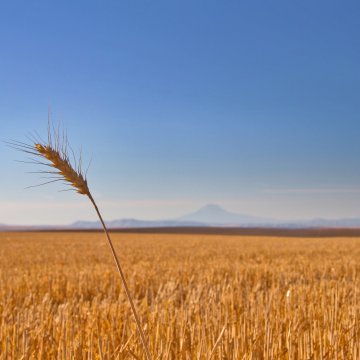
1. Wheat Lower in Overnight Trading, Soybeans Rise
Wheat futures were lower in overnight trading as more favorable weather moves into the southern Plains and eastern Midwest where winter varieties are overwintering.
As much as 8 inches of snow likely fell in southwestern Kansas and the Oklahoma and Texas panhandles in the past 24 hours, offering a protective blanket for overwintering hard-red winter wheat.
The 11- to 15-day weather outlook calls for a slightly wetter pattern, Commodity Weather Group said in a report, which will boost soil moisture.
Still, any precipitation is expected to miss the northwestern third of the U.S. Wheat Belt, which is already dry, CWG said.
Soybeans were higher overnight even as precipitation in Brazil, the world’s largest exporter, offers some relief for parched crops.
Rain fell in the south-central part of the South American country, and some precipitation is expected in the center-west this weekend, the forecaster said.
Still, more than a third of central Brazil is still under stress, which “begins to narrow late week, but long-term deficits linger,” CWG said. The rainfall deficit in the country remains a concern.
Capping price gains is the lack of demand for U.S. agricultural products recently. The Department of Agriculture hasn’t announced any large purchases of soybeans since Nov. 9 and no sales of 100,000 metric tons or more of corn since Monday.
Wheat futures for September delivery were down 4¢ to $5.84 ½ a bushel overnight on the Chicago Board of Trade, while Kansas City futures fell 3 3/4¢ to $5.50 a bushel.
Soybean futures for November delivery rose 4 1/2¢ to $11.57 ½ a bushel. Soymeal added $1.70 to $387.30 a short ton, and soy oil gained 0.33¢ to 37.25¢ a pound.
Corn futures fell 3/4¢ to $4.23 a bushel.
** **2. Ethanol Production Falls While Stockpiles Surge to Five-Month High
Ethanol production last week declined while stockpiles jumped to the highest level in five months, according to the Energy Information Administration.
Output in the seven days that ended on Nov. 27 dropped to an average of 974,000 barrels a day, down from 990,000 barrels the previous week, the EIA said in a weekly report.
In the Midwest, by far the biggest producing region, production fell to 926,000 barrels a day, on average, from 940,000 barrels a week earlier.
Gulf Coast output declined to 16,000 barrels a day from 17,000, and West Coast production fell to 9,000 barrels a day from an average of 10,000 barrels the previous week, the agency said.
East Coast production was unchanged at 13,000 barrels a day and Rocky mountain output stayed at an average of 10,000 barrels a day, the EIA said.
Stockpiles, meanwhile, jumped to 21.24 million barrels on Nov. 27.
That’s up from 20.866 million barrels the prior week and the highest since the seven days that ended on June 12, the EIA said in its report.
**
3. More Snow, Strong Winds Expected in Parts of the Southern Plains
Winter weather is continuing this morning in parts of the southern Plains, according to the National Weather Service.
A winter storm warning is in effect for counties in southern Kansas, northern Oklahoma and the Texas panhandle as another 1 to 3 inches of snow is expected to fall before ending early, though winds of 35 miles an hour are still in the forecast, the NWS said in a report.
Visibility is down to less than a mile.
“Road conditions are very poor across the warning area,” the NWS said. “Roads are snow and ice packed as temperatures fall further below freezing, and travel is not recommended through sunrise. Light snow and drifting snow will continue through sunrise.”
A winter weather advisory is in effect for a more broad area in the southern Plains encompassing almost all of southwestern Kansas, the western half of Oklahoma and several counties in the Texas panhandle, weather maps show.
An additional 1 to 4 inches of snow are expected along with winds of up to 40 miles an hour, though the wintry conditions will taper off this morning.








 User Center
User Center My Training Class
My Training Class Feedback
Feedback












Comments
Something to say?
Log in or Sign up for free